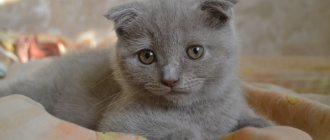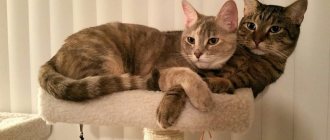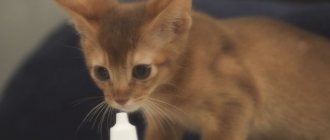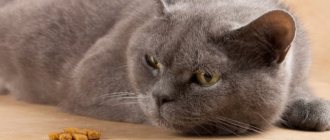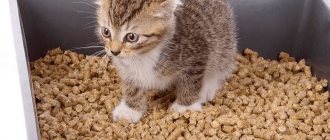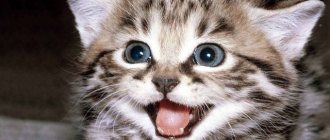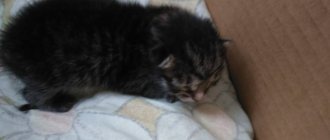If a one-month-old kitten does not poop for several days, the owner should be concerned about the baby’s condition, because long periods between bowel movements negatively affect the pet’s health and cause constipation. Therefore, if an animal is unable to go to the toilet for a long time, and is bothered by accompanying pathological symptoms, it is better not to delay a visit to the veterinarian.
Why a kitten can't poop: reasons
If a newborn cat under the age of one month does not go to poop for two or three days, but his appetite and health are good, there should be no cause for concern. The unformed digestive system is just getting used to the stress, and the intestines are testing their capacity. But when the baby is already eating complementary foods, but rarely visits the litter box - once every four or more days, the owner should pay attention to the pet’s behavior, because often such long breaks are a symptom of an internal disease.
The pathological reasons why small kittens cannot poop on time are:
- Constipation. Often bothers at the age of 2-3 months due to incorrectly introduced complementary foods. A one-week-old kitten may suffer from constipation due to congenital anomalies in the development of the gastrointestinal tract. If the second day ends and the baby does not go to the tray, you should feel his stomach. Elasticity and pain when pressed are a reason to visit a doctor.
- Gastrointestinal dysfunction. It mainly develops against the background of poor quality or unhealthy nutrition. It is also a symptom of a disease of a viral infectious nature.
- Worm infestation. A common reason why a kitten has not pooped for 3 days or more. When parasites are actively multiplying, the animal still eats little or, conversely, has an increased appetite, but the baby does not gain weight well.
- Stress. When a cat is separated from its mother, it reaches its second or third month. Parting with a mother cat is a strong stress, against the background of which the baby cannot go to the litter box on time. It is important to help the kitten quickly adapt to its new home, then the functioning of the intestines will soon return to normal without special treatment.
What to feed a cat with constipation
If constipation occurs, you need to reconsider the animal's diet. Food should be light with plenty of water or low-fat broth based on chicken meat (skinless fillet) or vegetables (various types of cabbage).
Be sure to read:
The cat has dark urine: causes and treatment, what should be normal, what the color change indicates
The kitten's diet includes:
- fermented milk products (kefir, yogurt);
- boiled vegetables (pumpkin, carrots, beets, zucchini)
- fiber-rich cereals (oatmeal, pearl barley, millet).
The main thing is that the diet needs to be balanced with the gradual introduction of different foods for the kitten.
Do not neglect preventive measures or feed only dry food.
Symptoms that require you to visit a doctor
The combination of absence of bowel movements and meowing in a baby is a good reason to take him to the veterinary clinic.
If a cat does not pee or poop for more than 2 days, this is a dangerous sign indicating the progression of some internal disease. In addition to problems with bowel movements and urination, other pathological symptoms are often present:
- bloating;
- pain on palpation;
- decreased appetite;
- temperature increase;
- rapid weight loss;
- lethargy, drowsiness;
- incessant meowing.
A newborn kitten aged 1-2 weeks should go to the toilet 3-6 times a day. But 6-8 week old kittens who have tried complementary feeding should visit the litter box once a day every day.
“Worms”: how to identify uninvited guests
In modern conditions, helminthic infestations seem to many to be something casuistic, and therefore do not cause concern. In fact, “worms” still occupy a prominent place in the structure of persistent deficiency conditions (especially often iron), pathologies of the liver, skin, and bronchopulmonary system. And identifying them requires understanding a number of features.
"Whelminthic" symptoms
It is worth noting that parasites do not benefit from the death of the host. Therefore, their presence, as a rule, is not accompanied by any signs for a long time.
1. Loss of appetite and unmotivated weight loss may come to the fore.
2. Also characteristic are recurrent deficiency conditions, the “nutritional” or any other origin of which has already been excluded. And most often, “carriers of worms” suffer from iron deficiency anemia.
3. In addition, parasites irritate the immune system, due to which they can provoke the development of allergic (including bronchial asthma) and atopic diseases.
4. If worms and larvae “choose” the intestines to inhabit, among the first signs of invasion there may be dyspeptic symptoms such as nausea, stool disorders, flatulence, periodic abdominal pain, as well as intolerance to certain foods.
5. And when the liver comes under attack, most often the “finding” is accidental, in the form of an “unexplained” increase in markers of liver inflammation (ALT, AST) or changes on ultrasound.
Therefore, first of all, the examination is indicated for those who already have similar pathologies of unknown origin, or a high risk of infection (for example, trichinosis from eating undercooked meat of pigs and wild boars or lard with layers of meat).
When “feces” is not informative
The most famous study is undoubtedly the “feces on worm eggs.” However, this analysis has a number of objective disadvantages, due to which it is not capable of providing high detection of parasites.
Firstly, feces can help in identifying only those helminths that have “stopped” at the intestinal level. While the larvae are able to migrate to a number of other organs, including the liver, muscles, lungs and even the brain.
Secondly, the analysis is designed to detect only worm eggs, that is, it is highly dependent on the life cycle of the parasite.
“Guessing” at what point in time the worms will “decide” to lay eggs is obviously an impossible task. After all, there are no visual signs of this stage of their “life”.
Therefore, it is recommended to test feces for helminths several times (at least 3) with intervals of several days. And even in this case, the “chances” of identifying parasites remain quite low.
A blood test for antibodies to helminths does not have such disadvantages, and the sensitivity of the study to different types of worms reaches a high 75-90%.
In this case, IgG antibodies appear in the blood 3-4 weeks after infection. The analysis can be carried out either specifically to the type of parasites of interest, or comprehensively, taking into account the most common parasitoses.
The detection of antibodies to parasites in the blood is a justified reason for the use of drugs and an in-depth examination of the target organ, even if nothing bothers the patient.
And, among other things, such an analysis successfully complements traditional diagnostics based on stool analysis.
Diagnostics
A preliminary diagnosis of a furry can be made based on the results of a physical examination.
If your kitten has not pooped for 2 days or more, and it seems that he cannot do it on his own, you should take your pet to a veterinarian, who will help determine the cause of this condition. The doctor will examine the cat, ask the owner what symptoms are bothering the animal, and collect other important data. To determine an accurate diagnosis, referral is given to a number of additional diagnostic procedures:
- general blood and urine analysis;
- microbiological examination of stool;
- biochemistry;
- Ultrasound of the abdominal organs.
Diagnosis and treatment of constipation at the EXPERT Clinic
What and how can we help you?
- Consult with a competent specialist - our gastroenterologist will examine you in detail, if necessary, prescribe additional consultations with related specialists and monitor the treatment process, from the first visit to the result.
- To identify the cause of constipation - we have all the necessary expert-class equipment and highly qualified diagnostic specialists to conduct a detailed examination - tests, ultrasound, endoscopic examinations.
- Save you time and money - to find out why your intestines are refusing to work regularly, we have created a free conversation with a gastroenterologist to schedule an examination. If you are concerned about your symptoms, but you don’t know where to start, during the conversation you will be prescribed the necessary range of tests.
What treatment is prescribed?
If a Sphynx, British, Scottish or other breed has problems with bowel movements, the first thing you need to do is review the diet. It is possible that the cat eats low-quality food, which is the reason for the problems that disrupt digestion. When feeding dry food, it is important to ensure that the animal always has clean, fresh water freely available.
Vaseline oil will make it easier for your fluffy to defecate if he takes it several times a day.
If a kitten wants to go to the toilet, but cannot, it is recommended to periodically give it a microenema. The liquid for the procedure, be it saline solution or ordinary boiled water, should be slightly cooler than room temperature. This will help activate intestinal motility, so that stool will quickly leave it. Another way to get a kitten to go to the litter box is to take Vaseline oil. It is recommended to give the product to the baby 2-3 times a day, 1.5 ml per kilogram. This oil is useful for constipation because it is not digested in the stomach and is not absorbed by the intestines, due to which the walls are enveloped in the substance. The feces immediately soften and the cat can poop without any problems. It is important to remember that you cannot replace Vaseline oil with vegetable oil - sunflower, olive or castor oil, since they are absorbed in the colon and do not have any effect.
If such methods do not cope with the problem, and the kitten does not poop for many days, there is nothing left to do but start taking medications. The drug is prescribed only by a veterinarian after determining an accurate diagnosis. Lactose-based medications are used. The following are considered effective:
- "Duphalac";
- "Lactusan";
- "Lizalak."
How to tell if a kitten is constipated
The animal becomes restless, runs around, looks for a place to go to the toilet, meows loudly when it sits in the tray for a long time. When palpating the abdomen, he tries to escape, since such movements cause pain for him.
When feeling the stomach, you can feel an oblong lump along the body, mainly on the right side, or a foreign object.
In a kitten, prolonged absence of stool can cause vomiting, lethargy, fever, and intermittent breathing.
What to do for prevention?
If the baby has not yet gotten used to the new owners, then their task is to accustom him to the new toilet.
As soon as the kitten appears in the house, you must immediately introduce him to his personal toilet and show him where the litter box is located. Sometimes in a new place an animal does not know where to relieve itself, and its upbringing does not allow it to go anywhere. In this case, the baby suffers, which is why constipation appears. Another important point is the selection of proper, balanced nutrition. It is better to create a diet or select a suitable brand of ready-made food together with a veterinarian.
It is forbidden to suddenly switch to a new type of food, and if the cat eats natural food, it is important to ensure that prohibited foods do not fall into his bowl - fried, spicy, salty, fatty, sweets. In addition, you should periodically give your pet anthelmintic drugs, and promptly treat the animal for fleas, lice and ticks. If there are characteristic symptoms of digestive disorders, do not self-medicate, but take your four-legged friend to an appointment with a veterinarian.
Consequences of constipation
Constipation is always a symptom of disorders in the body, so diagnosis and treatment are necessary. Dangers of regular constipation:
- development of an imbalance of intestinal microflora (dysbacteriosis), which provokes a decrease in local and general immunity, disrupts digestion processes, and causes deficiencies of vitamins, microelements, and nutrients;
- dysfunctions and diseases of the gastrointestinal tract (diverticulosis, hemorrhoids, inflammatory processes, etc.);
- intoxication of the body due to prolonged presence of feces in the intestinal cavity;
- formation of polyps, intestinal tumors;
- intestinal obstruction.
The only correct solution for constipation is to contact a gastroenterologist to exclude serious diseases, examination and correction of the condition.
The final stage of the procedure
This procedure will have a positive effect on the condition of your furry pet. Firstly, massage helps to improve intestinal motility and increase blood circulation, which will undoubtedly affect the overall well-being of the animal. Secondly, the kitten will be able to learn to trust the new owner, perceiving him in no other way, namely in the role of a mother cat. Thirdly, without resorting to the use of medications approved for use only after veterinary consultation, you can cope with the problem and make the kitten’s life easier.
If everything went according to plan and the desired result was achieved, the next step is cleaning. You need to start with the animal. After defecation, you must carefully wipe your pet's butt, being careful not to damage the anus or cause any infection.
The next step is to clean the surface over which the manipulation was carried out. Having removed the kitten to its usual resting place, you can begin cleaning. It is advisable to use harmless disinfectants. If the kitten is not the only inhabitant in the house among the small furry balls, then everything is ready for the procedure with the following ones.
At the end of the manipulations, it is important not to forget about simple hygiene rules and mandatory hand washing.
Toilet in the apartment
How to train a kitten to use the toilet in an apartment? Not all owners have the opportunity to take their pet outside after each feeding, especially since in the courtyard of a multi-story building there are many hidden dangers, ranging from physical injuries to infectious and invasive diseases. Therefore, it is advisable to accustom the kitten to the toilet in the apartment. To develop a strong habit, you need to take your baby to the place where the tray will be or is already located. When choosing a place for a cat's litter box, you need to take into account several nuances: cats do not like to be looked at during such a delicate task, the tray should be easy to get from this place.
Help for newborns
If the newborn baby in your care cannot recover on his own, you must help him. There is nothing complicated in this procedure. Don’t forget that experienced cat mothers, despite the lack of video lessons and courses on caring for newborns, successfully cope with this responsibility. Moreover, everything should work out for you! The main thing is to calm down and follow the instructions exactly.
Stock up on damp cotton wool, a napkin or a soft, clean cloth, or better yet, several. Place them on the table in front of you on the side of your dominant hand so that you can quickly replace the dirty one with a fresh one. You will need them to stimulate the anus, just like mother cats do.
Cover the table on which you will perform the procedure with old film or other hygroscopic fabric that absorbs liquid well.
Sit in a comfortable chair so you have support for your arms. Take the kitten in your left hand (if you are right-handed), with the tail facing you. Be very careful! Don't squeeze your baby too tightly. At the same time, try to hold it so that it does not slip out of your hands and get hurt.
Begin to carefully, in a circular motion, massage the anal and genitourinary openings with a piece of slightly damp cotton wool. This will help stimulate the excretory reflex. Replace used materials with fresh ones as necessary.
At the end of the procedure, all that remains is to return the baby to the basket, throw all used materials in the trash and wash your hands thoroughly.
You need to do this massage every day, for a minute or two. You are doing everything right if your ward was able to poop or at least pee during this time. If neither one nor the other happens, you need to show the baby to the veterinarian.
Diet
What can you give your child for constipation?
This question interests many parents. The fight against the problem should begin not with taking medications, but with changing your diet.
Necessary:
- Increase fluid intake
- Set up fractional meals
- Add fiber-rich foods to your diet
You should teach your child to drink plain, clean water. Typically, for children over 3 years of age, 2-3 glasses of water per day are sufficient. Sugary carbonated drinks, coffee and tea should be avoided. This is due to the fact that they have a pronounced diuretic effect and stimulate constipation and dehydration.
Cool water, which children drink in the morning on an empty stomach, is especially beneficial. Gradually, the temperature of the liquid can be reduced. The following drinks also have a laxative effect:
- beet juice
- fermented milk (kefir, fermented baked milk, etc.)
- chamomile decoctions
- tea with dill
Important! They should be introduced into the diet gradually, starting with small amounts. Otherwise, you can provoke digestive breakdown.
You should teach your child to drink plain, clean water. Typically, for children over 3 years of age, 2-3 glasses of water per day are sufficient.
Treatment of constipation in children also involves the introduction of foods with a laxative effect into the diet, which include:
- legumes
- nuts
- prunes and dried apricots
- plum
- beets
- dates
They are also included in the diet gradually and under the supervision of a doctor. Cereal porridges may be useful: oatmeal, buckwheat, wheat, pearl barley. It is advisable to avoid rice, pears, sweets, baked goods, animal fats, and flour products. They have a fixing effect.
What else should I feed my baby to avoid constipation?
The answer to this question should be given by a pediatrician.

